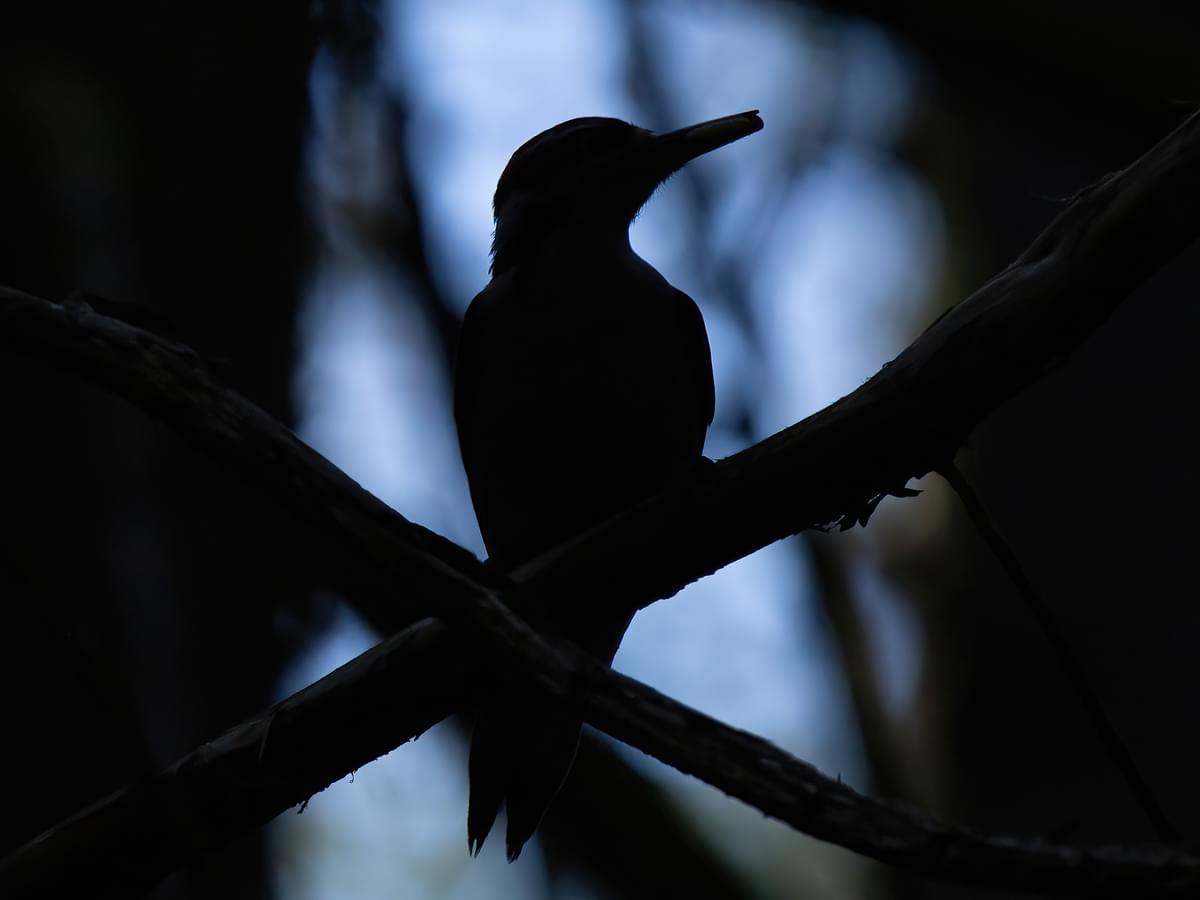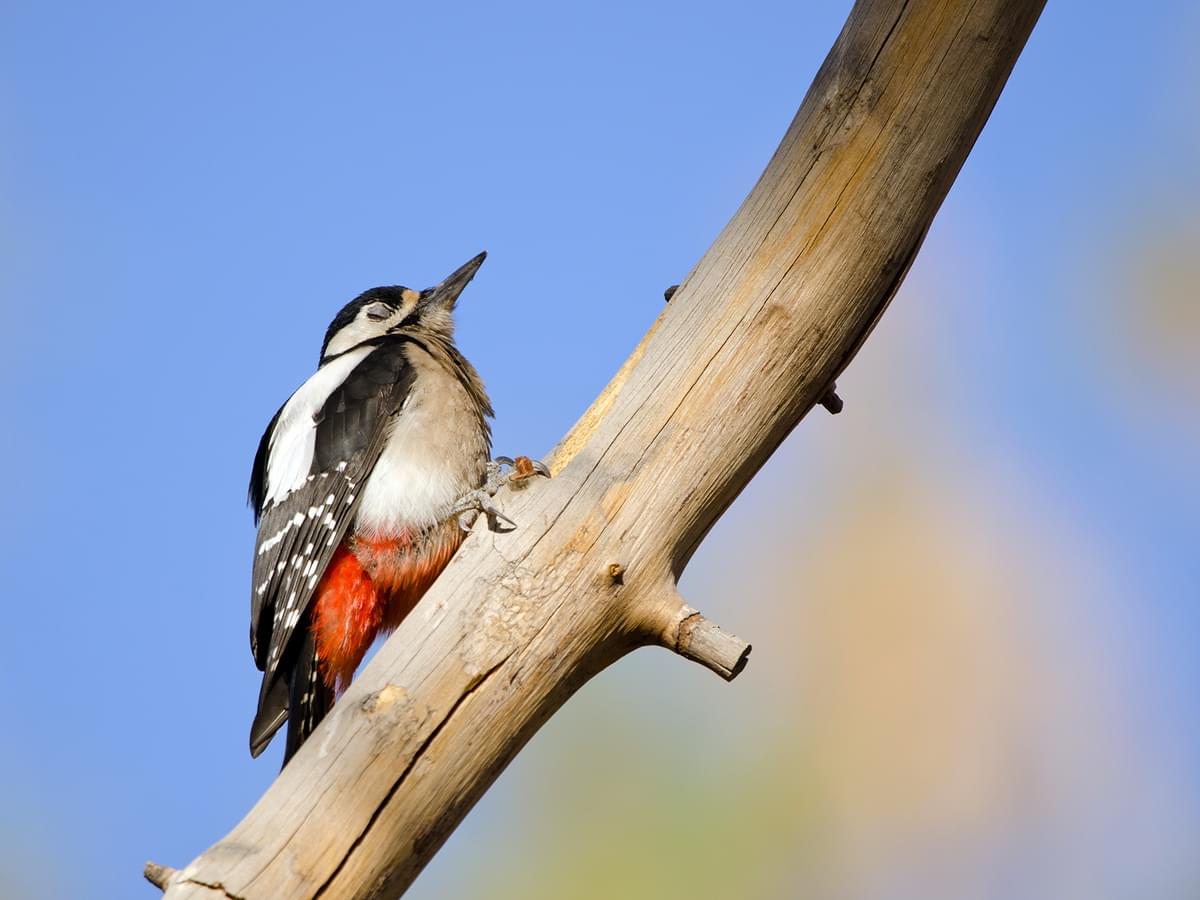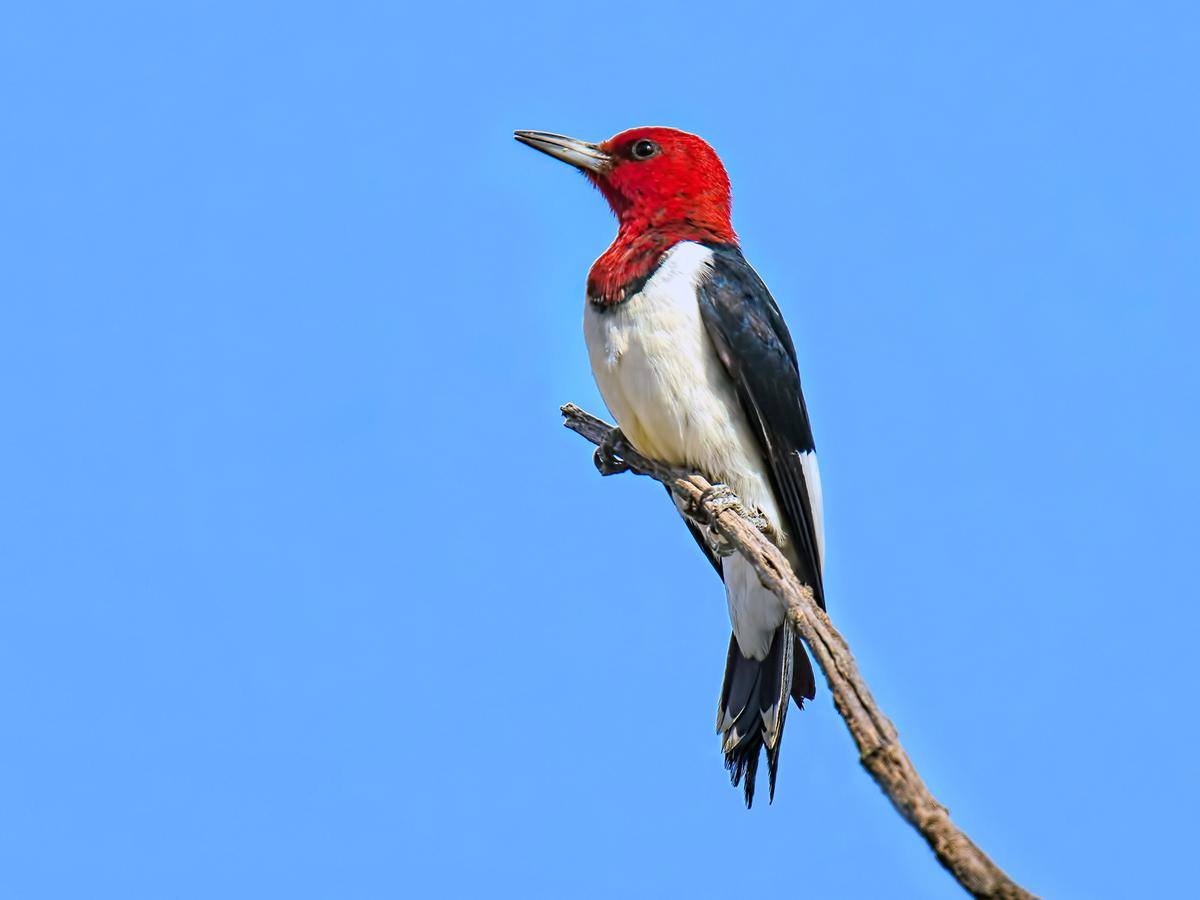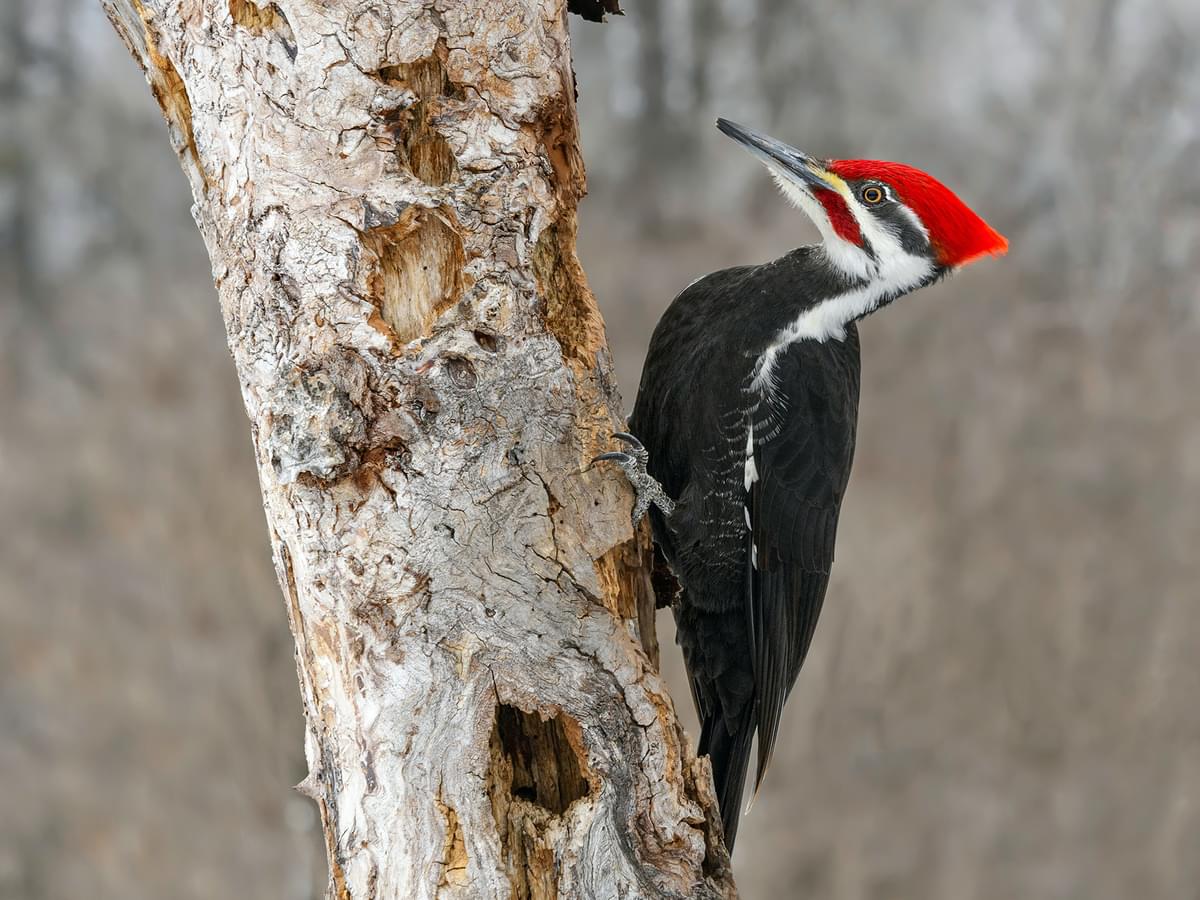Woodpeckers
With over two-hundred representatives in the Picidae family, Woodpeckers are a widespread and diverse group of birds with some remarkable behaviors and bizarre adaptations. Largely built for life in the trees, they occupy many habitats, from rainforests to deserts and even treeless mountain slopes.
Woodpeckers are beautiful birds, often with striking colors and interesting behaviors. However, they appeal to more than just birdwatchers. They are also vital for maintaining healthy ecosystems, controlling pests, and creating homes for many other bird and animal species.
Are you ready to explore the wonderful world of Woodpeckers? Read along with us to learn all about their behavior, diversity, ecology, and much more!
Woodpecker Anatomy
Woodpeckers are distinctive birds, easily recognized by their sharp, straight bills, short legs, robust feet, and medium-length tails. Most species have boldly marked heads, and many have colorful crests that they can raise at will.
Continue reading to learn more about Woodpecker appearance and anatomy.
Size
Woodpeckers range in size from the tiny Bar-breasted Piculet (Picumnus aurifrons) of South America at just 3 inches (7.5 cm) long and ⅓ ounce (9 g) to the Imperial Woodpecker (Campephilus imperialis) of Mexico which reaches or reached (the species may be extinct) 22 inches (56 cm) in length.
Plumage
Their plumage color varies greatly across the world, but a large proportion of the world’s Woodpecker species are dark above (black or green), pale below (white or whitish), and have some red markings (typically on the head).

Red markings on the head are fairly common amongst Woodpeckers - pictured a Pileated Woodpecker
Bill
The family has many unique physical adaptations that enable their specialized feeding and nesting behaviors. The most noticeable of these is their chisel-like bill, ideal for pecking into wood to access insect larvae living within and for excavating nesting and roosting chambers.
Tongue
Woodpeckers drill into wood to access their prey directly or to tap into insect colonies or tree sap. Their prize may be further into the wood than they can reach and pretty difficult to extract. So how do Woodpeckers retrieve small invertebrates like ants and their larvae?
The secret is an extra-long tongue that can be an incredible 30% of their total body length! This extendable tongue wraps around the bird’s skull when not in use.
The tip of the Woodpecker’s tongue is equipped with sharp barbs that grip their prey so the bird can pull its meal out of its tunnel.

Close up of a Woodpeckers tongue (Red-bellied Woodpecker)
Brain
Woodpeckers can hammer away at over twenty pecks per second, which is enough to make you dizzy just thinking about it. Of greater concern is the kind of damage that impact could do to their brains.
Scientists are still working out exactly how these birds get away without too much trauma, but it seems as if the tiny size of their brains minimizes damage. Their skulls do not absorb impact as previously thought because, in practice, any cushioning effect would reduce the effectiveness of their pecking.
Feet
Woodpeckers cling to tree trunks and branches while they forage, requiring serious grip strength. Most bird species have three toes facing forward and one facing back, but Woodpecker toes are arranged in an X-shape, known as a zygodactyl foot shape.
Each toe is tipped with a sharp, strongly curved claw, and this combination of strength and traction allows them to hang upside down with ease.
Tail
Gripping a tree trunk and pounding away with your bill requires grip and bracing. Woodpeckers use their stiff tails to push against the tree trunk for support and balance.

European Green Woodpecker perched on a branch
Understanding Woodpecker Behavior
Pecking
Pecking on a live hardwood tree is tough work, even for a Woodpecker. However, not all wood has the same structure, and Woodpeckers use this fact to their advantage. They prefer decaying wood, either on dead trees or those with dead limbs caused by fungal infections. This kind of wood houses the most insects and is easiest to nest in.
Some Woodpeckers peck to create storage. The Acorn Woodpecker (Melanerpes formicivorus) drills numerous acorn-sized holes where it wedges these nuts as a winter food source. This keeps them safe from other animals and prevents them from rotting or being covered on the ground.
The ability to chisel out a hole into wood allows these birds to create ideal nesting spaces that are sheltered from wind, rain, and most large predators. Adult Woodpeckers benefit from getting out of the elements too, and most will excavate a chamber specifically for roosting at night.
These birds don’t only peck to make holes in wood. They also use their anatomical superpowers to communicate. Continue reading to learn about Woodpecker drumming.
Check out our in-depth guide on Why Woodpeckers Peck Wood for more information.
Learn more about Woodpecker Pecking

A pair of Acorn Woodpeckers storing acorns for the winter
Drumming
You may have heard a Woodpecker softly tapping away at a tree trunk while feeding. At other times, their pecking is audible from a long distance and seems to follow a rhythm or frequency. This loud, rhythmic pecking is known as drumming, and it is done to communicate with other members of their species rather than to find a meal or build a nest.
Woodpeckers choose hollow wood for drumming because it resonates well and makes a lot more noise. Some individuals have also learned to drum on other surfaces like gutter pipes, roof vents, and even windows for the same reason.
Vocalizations
Drumming isn’t the only way that Woodpeckers communicate. They are not songbirds (passerines), but they do produce calls to attract mates, reinforce their bonds, express alarm, and ward off enemies. Some species are highly vocal before nesting, and their calls can be a great way to track them down.
Learn about Woodpecker Sleeping Behaviors

Woodpeckers do make calls and alarm sounds - Northern Flicker
Different Species of Woodpeckers
Woodpeckers are a diverse group of birds with approximately 230 known species in the Picidae family. Many species occur in temperate regions of the world, and American birdwatchers could spot over twenty species of Woodpeckers, Sapsuckers, and Flickers in the United States.
Let’s take a look at a few of the more widespread and notable American Woodpecker species.
Woodpeckers in North America
Downy Woodpecker (Dryobates pubescens)
America’s smallest Woodpecker is also one of its most common species. The Downy Woodpecker is a familiar bird at many backyard bird feeders and can be seen in just about any wooded habitat in the United States and Canada.
Pileated Woodpecker (Dryocopus pileatus)
In stark contrast with the compact Downie, Pileated Woodpeckers are large, crow-sized Woodpeckers with a scarlet-red crest. Although comfortable in the trees, this species also descends to feed on fallen logs.
Northern Flicker (Colaptes auratus)
The Northern Flicker is a fairly large species that is mostly brown rather than black and white. In typical Woodpecker fashion, they do have bold black and red markings on their heads and elsewhere. These birds peck into wood to create nest cavities, but interestingly, they prefer to find their food (primarily ants) in the dirt instead of tree trunks.
Yellow-bellied Sapsucker (Sphyrapicus varius)
The Yellow-bellied Sapsucker has a more vegetarian diet and specialized feeding technique than the previous three species. These widespread American birds feed on sap that they access by drilling holes into tree bark. Like many other Woodpeckers, they supplement their diet with fruits, berries, and insects.
Woodpeckers in the United Kingdom
Europe may have lower Woodpecker diversity than North America, but birdwatchers in the United Kingdom can still spot four species, including the fascinating but scarce Wryneck.
Greater Spotted Woodpecker (Dendrocopos major)
The Greater Spotted Woodpecker is the UK’s most common Woodpecker species, and also it’s most boldly marked. These vivid black, white, and red birds are similar in pattern but much larger and more numerous than the Lesser Spotted Woodpecker.
Green Woodpecker (Picus viridis)
With a body length of over 12 inches (30 cm), the Green Woodpecker is the largest British species. Like the Northern Flicker of the New World, Green Woodpeckers deviate from the norm in both color and feeding habits. They also feed on ants on the ground, and they are mostly green rather than black and white.
Read our guide to Woodpeckers of the UK for more information on each of the four British species.
Distribution, Habitats and Migration of Woodpeckers
Unless you live ‘down under,’ chances are good there’s a Woodpecker near you. Read along to learn more about where Woodpeckers live.
Distribution
Woodpeckers and other members of the Picidae occur everywhere from the equator to the Arctic, but curiously, their family is absent from Australia and New Zealand.
Here’s a breakdown of the distribution range of the various groups in the Woodpecker family:
- Woodpeckers: North & South America, Europe, Asia, Africa
- Wrynecks: Europe, Africa, Asia
- Sapsuckers: North America
- Flickers: North & South America
- Piculets: South America, Asia, Africa
Habitats
Woodpeckers occupy a variety of habitats, although most species live in wooded areas like savannas, woodlands, and forests. Some species have adapted to feed on the ground and can be seen in areas where trees are scarce or even absent.
Food availability and nesting sites are important factors that determine where Woodpeckers live. Some species, like the Gila Woodpecker (Melanerpes uropygialis), occupy relatively specific habitats and are associated with certain plant species.
Others, like the Northern Flicker (Colaptes auratus), are far more adaptable but cannot survive in all parts of their range in every season. Like so many other birds, they solve this problem by migrating.

Close up of a Gila Woodpecker perched on top of a cactus, Baja California Sur, Mexico
Migration
The various Woodpecker species differ in their movements and migrations, and many are territorial and sedentary.
Accessing insects within the wood of trees secures a year-round food source above the blanket of snow for birds like the Hairy Woodpecker (Picoides villosus) of North America. Excavating their own insulated roost cavity is another excellent survival strategy in harsh climates.
However, some species are more mobile. North America’s Yellow-bellied Sapsucker (Sphyrapicus varius) and the Wryneck (Jynx torquilla) of Eurasia are highly migratory.
Migrating Woodpeckers have two main strategies for escaping the cold conditions of winter. Most move from north to south since winters are warmer near the equator, while others may simply move to lower elevations to avoid harsh mountain weather.
Learn more about Woodpecker migration
The Diet of Woodpeckers
Woodpeckers are omnivorous birds that feed on invertebrates, small vertebrates, berries, seeds, and tree sap. They find their food in a number of ways, although they are well adapted for drilling into wood or scaling the bark of trees.
Woodpeckers that are tapping on wood are often looking for the following insects:
- Carpenter bee larvae
- Woodboring beetles
- Ants and their larvae
Woodpeckers can also catch invertebrates by simply gleaning them off the surface of bark or other plant surfaces, and some agile species snatch flying insects right out of the air.
They are adaptable birds, however, and their diet may vary at times of the year. Many species visit bird feeders in backyards, where their favorite food is usually suet. They also eat other common bird foods like sunflower seeds and corn, and some even enjoy a sip of nectar at hummingbird feeders.
Some species have more specific diets and feeding strategies. The Sapsuckers (Sphyrapicus spp.) of North America specialize in eating tree sap, which they access by drilling neat rows of holes in their favorite tree trunks and waiting for the nutritious liquid to well up.
Read our in-depth article on What Woodpeckers Eat to discover how, where, and when these special birds find their food.
Learn more about the diet of Woodpeckers

Greater Flameback Woodpecker searching for termites
Reproduction and Lifespan of Woodpeckers
Nesting
Most Woodpeckers are monogamous cavity-nesting birds that excavate their own nest chambers, usually in tree trunks. The size of the entrance depends on the size of the species that made it, and the chamber varies in depth, with some species digging down as much as two feet.
Woodpeckers may excavate their nests on the underside of sloping branches or just below limbs, which helps to prevent flooding in rainy weather. They usually prefer dead or rotten wood, which is softer and easier to peck into. However, some also excavate into utility poles and the timber used in our homes and other buildings.
Woodpeckers typically lay plain white eggs, and clutch size varies between species. Four to five eggs are common, but some species can lay clutches of over ten eggs. Both sexes usually incubate and care for their young, which hatch after anything from eight days to three weeks and fledge the nest three to four weeks later.
Lifespan
Woodpeckers are not particularly long-lived birds. Most species have an average life expectancy of just a few years, but some can live for over a decade. Like other small to medium-sized birds, they have many potential predators, including birds of prey, mammals, and even reptiles.
Woodpeckers are not very common in captivity, although various species have been kept and bred in zoos. Like many other birds, they may have a higher life expectancy if kept in healthy conditions and provided with a natural diet.

Close up of a Great Spotted Woodpecker feeding a young chick in the nest
Woodpeckers and Humans
Damage
Woodpeckers and humans don’t always get along due to their pecking and drumming behaviors, but do these birds really deserve a bad rap?
Woodpeckers occasionally damage homes by pecking holes in timber. They may feed on insect larvae in rotten or untreated wood or excavate larger holes for nesting and roosting. Deterrents for Woodpeckers such as reflective tapes can be effective, but these birds should not be disturbed once they have begun to nest.
Damage to trees in landscaping and forestry is another concern, but Woodpeckers rarely cause severe damage to healthy trees. However, large species like the Pileated Woodpecker can cause small dead or dying trees to topple over completely, and Sapsuckers can increase stress and potentially leave trees open to pests and infection.
Some species, like the Great-spotted Woodpecker, feed on the eggs and chicks of other cavity-nesting bird species. These birds can damage birdhouses when enlarging the entrance hole to get at their unfortunate victims. Reinforcing the entrance with a steel plate can be helpful, but not if the determined bird pecks a hole into the side of the box.
Benefits
Woodpeckers fill a vital role in ecosystems as both predators and prey, but they are also ecosystem engineers that create benefits for other species that last outlast the Woodpecker’s lifespan. They often use nest cavities just once, leaving them available to many other animals and birds that cannot chisel out their own homes and nests.
The following birds are known to nest in disused Woodpecker holes:
- Little Owl
- Eastern Screech Owl
- Wood Duck
- American Kestrel
- European Starling
Woodpeckers can benefit trees by controlling populations of wood-boring insects. This can be beneficial to humans, too, especially in the forestry sector, where pest infestations can affect production.

Male Black Woodpecker (Dryocopus martius)
Folklore & Popular Culture
Woodpeckers have featured in human culture for thousands of years. Here are two well-known examples:
Picus was a minor god in Roman mythology, worshipped for fertilizing the soil. The myth goes that Picus was a man before being transformed into a Woodpecker by the goddess Circe.
The reason for this curse was his refusal to be unfaithful to his wife. Today, Picus is the generic name for a group of Woodpecker species, including the Green Woodpecker of Europe and Asia.
In (much) more recent times, a cartoon character named Woody Woodpecker delighted millions of children and adults alike with his infectious laugh and zany antics. He was brought to life in a popular cartoon TV show produced for over three decades in the mid-1900s, and an animated movie by the same name was released in 2017.
Conservation and Status
Many of the world’s Woodpeckers are common and widespread birds. However, the impacts of industrialization, deforestation, agriculture, pollution, and many other environmental problems affect these birds, and some are faring worse than others.
There is only one confirmed extinct Woodpecker species, the Bermuda Flicker. These birds are known only from archeological remains, although they probably survived until at least the 1600s. Two other Woodpecker species known from modern times are likely to be extinct, although they are still classed as ‘Critically Endangered on the IUCN Red List. These are:
- Ivory-billed Woodpecker (Campephilus principalis)
- Imperial Woodpecker (Campephilus imperialis)
A third species listed as critically endangered, the Okinawa Woodpecker (Dendrocopos noguchii), still clings to existence in a tiny population in Okinawa, Japan.
Learn more about the conservation status of Woodpeckers

Close up of the critically endangered Okinawa Woodpecker
Fascinating Woodpecker Facts
- The Great Slaty Woodpecker is the largest Old-World Species and possibly the largest surviving member of the Picidae family. Hailing from the jungles of South and Southeast Asia, these impressive birds reach nearly two feet long and can weigh over a pound.
- The Ground Woodpecker of Southern Africa forages on rocky mountain slopes, often far from trees. In case you were wondering, these sociable birds can’t peck into solid rock!
- Fossil discoveries indicate that Woodpeckers have been around since at least the early Miocene (± 15 - 23 million years ago).
- Despite the obvious color differences, Woody Woodpecker is said to be modeled on the Acorn Woodpecker of Mexico and the American Southwest. There are no bright blue Woodpeckers (that we know of).









